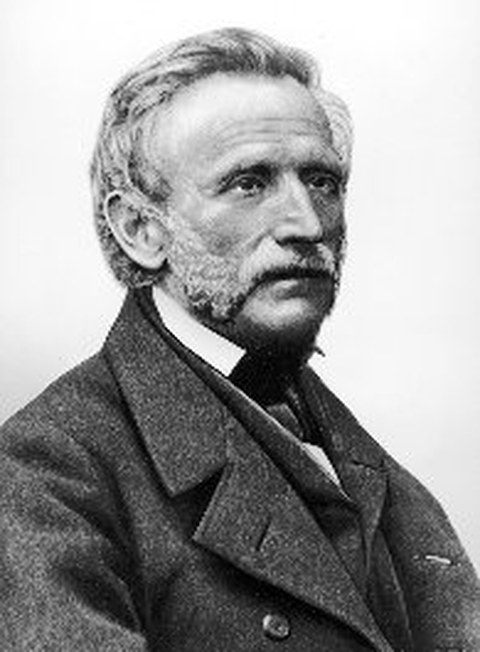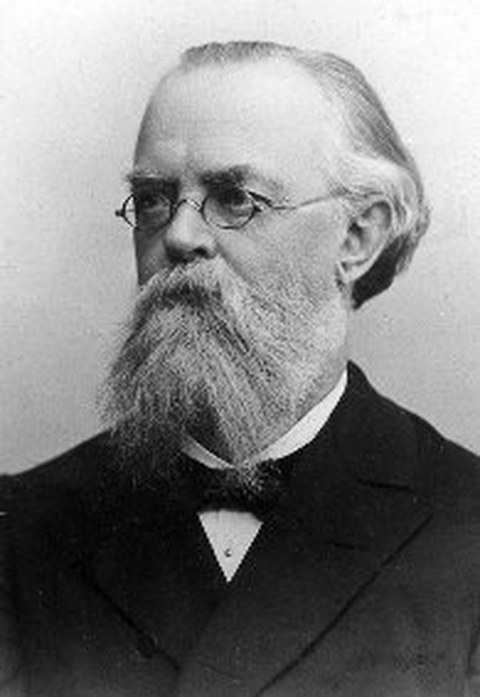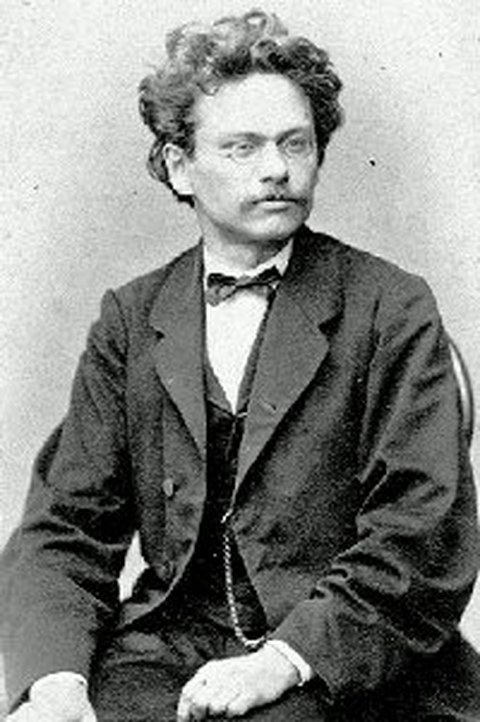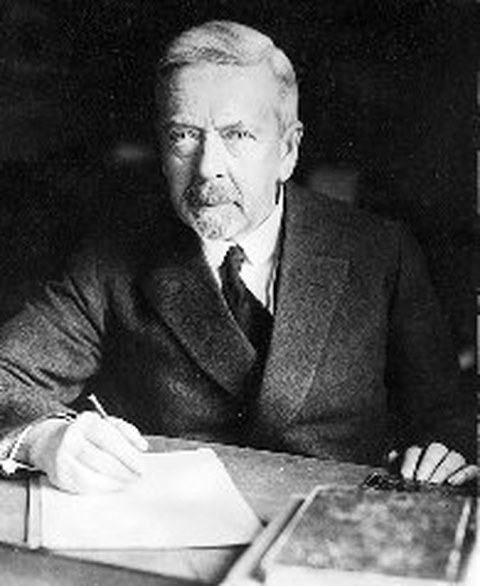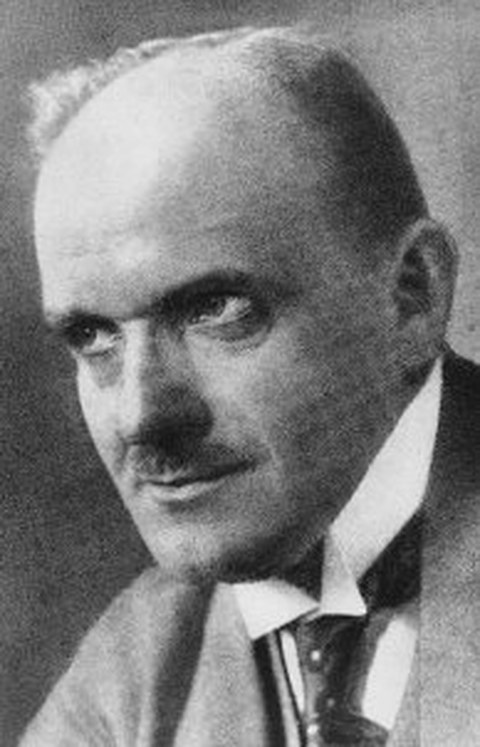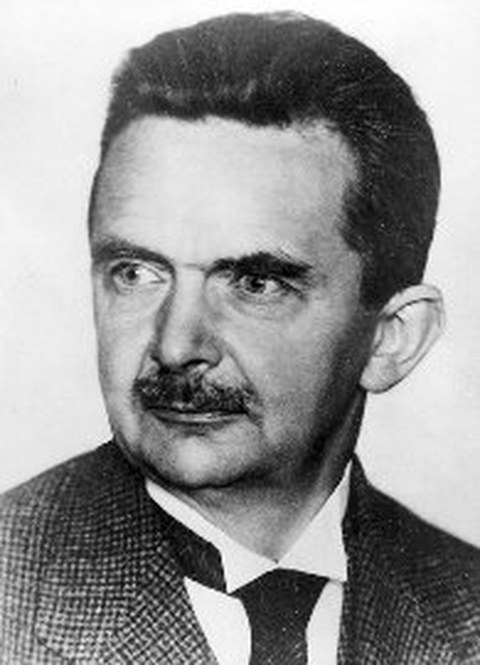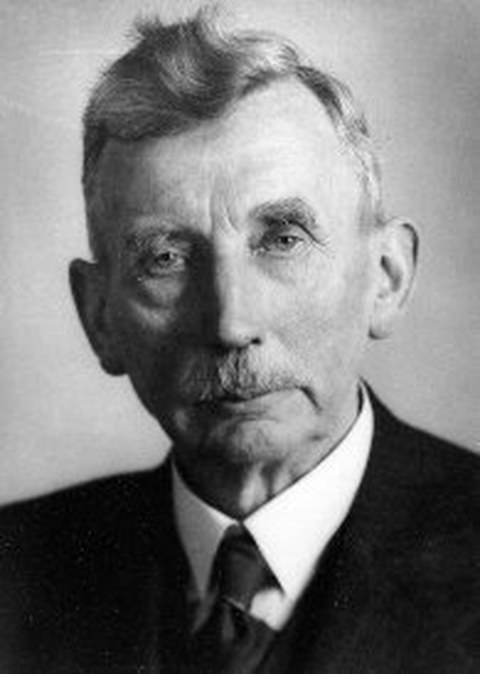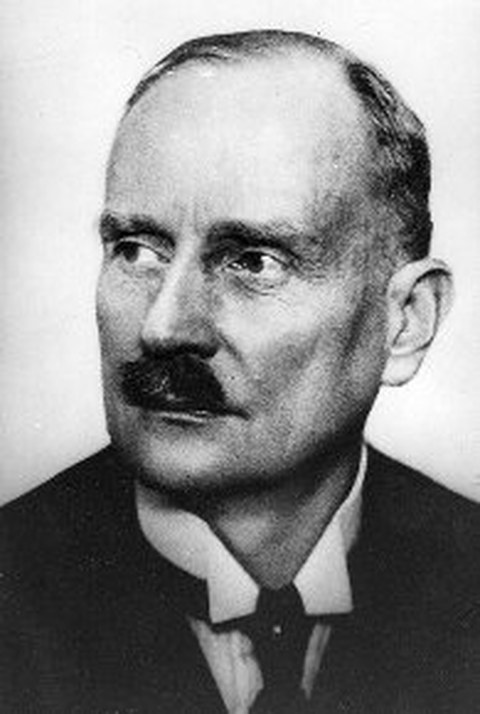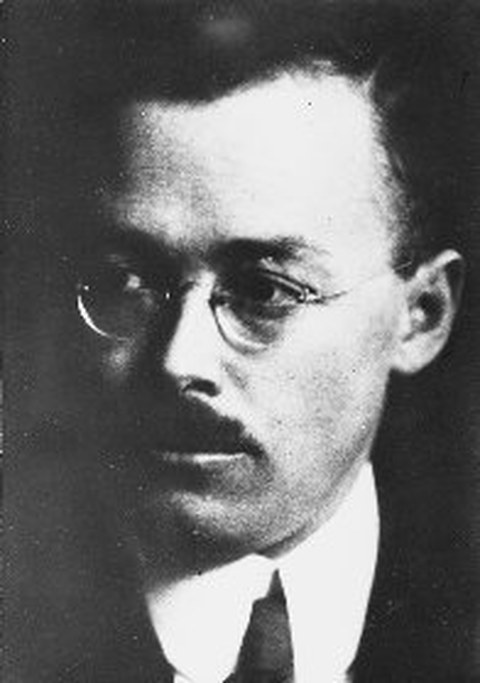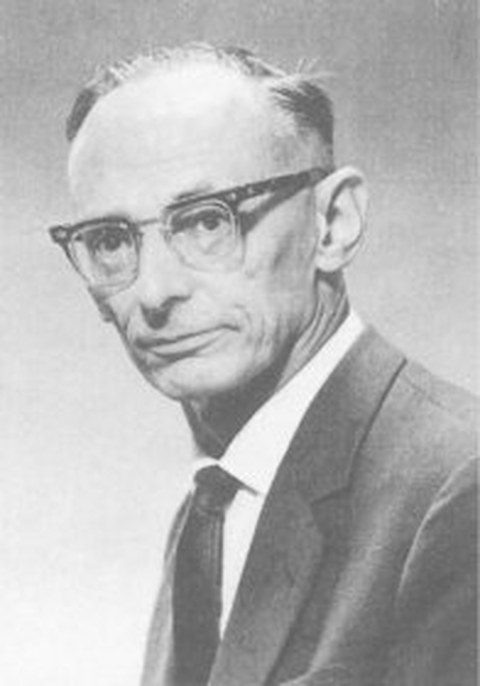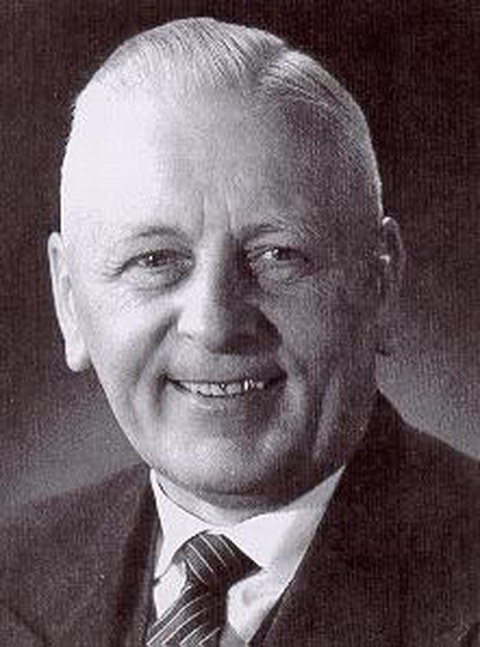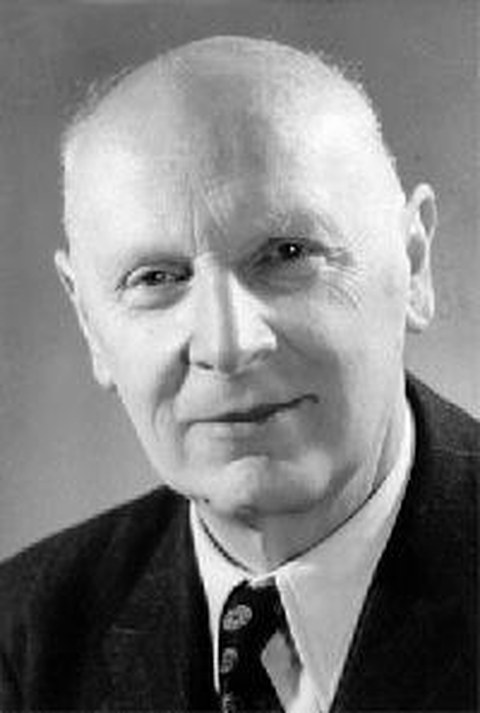The Faculty's History
Mechanical Science and Engineering as the Germ Cell of TU Dresden – the History of the Faculty
The establishment and growth of the Faculty of Mechanical Science and Engineering is closely linked with the industrial boom that occurred across Germany and Europe in the 19th and 20th centuries. Progressive scholars and politicians were aware of the great opportunities that the new applied sciences offered to cultural and scientific development of that time. It is thanks to them that the engineering sciences and engineering professions have won recognition and are now the driving force behind human progress.
The history of the Faculty of Mechanical Science and Engineering, from its beginnings as the Mechanical Division until today, has substantially impacted the development of TU Dresden as a whole.
When the Technische Bildungsanstalt Dresden – the forerunner of today's university – was founded in 1828 in the city on the Elbe, the industrial revolution in Saxony was only in its infancy. By establishing this new educational facility, however, Saxony was given the opportunity to train urgently needed mechanics and technicians for the local industry and thus promote industrial development.
Its first director was the geodesist, astronomer and meteorologist Wilhelm Gotthelf Lohrmann. Johann Andreas Schubert is generally regarded as the most distinguished scientist of the first decades. He was one of the most important Saxon engineers of the 19th century as well as a lecturer with extensive knowledge of mathematics, mechanics, mechanical engineering and civil engineering. He designed the first German steam locomotive, the Saxonia, and the first Saxon steamboats on the Elbe. The Göltzschtal Bridge in the Vogtland region also originates from his engineering plans.
The Technische Bildungsanstalt was a polytechnic school as early as 1851.
In 1871, it was recognised as the Royal Saxon Polytechnic, an important step on the way to becoming a technical university. At this early stage, a general department was established in which Chairs of Economics and Statistics, German Language and Literature, and Art History were united. This general department had an excellent reputation in the years that followed and made an outstanding contribution to the development of a universitas litterarum.
In 1865, the education of teachers for mathematics, science and technology began. The departments of mechanical engineering, civil engineering and chemistry soon gained a distinguished scientific position and helped the school to gain recognition beyond the borders of Saxony.
In 1878, habilitation regulations were passed and Diplom degrees were introduced in the early 1980s.
Gustav Anton Zeuner, an internationally renowned scientist in the field of theoretical mechanics and technical thermodynamics, made great contributions during this time. He took over the management of the school and made the Polytechnic into an institution with universitarian character.
In 1890 this was finally officially confirmed with the recognition as a Technische Hochschule and in 1900 it earned the right to award doctorates. During the late 19th century and the first decades of the 20th century, the university established its definitive academic identity. New institutes were connected with the work of many important scholars at the university. In addition to Heinrich Barkhausen, who founded the first institute for low-current technology (Schwachstromtechnik) in Germany at TH Dresden in 1911, the chemists Fritz Foerster and Walter König, the high-current engineer Ludwig Binder, and the metrologist Georg Berndt were among them.
The famous romance languages scholar Victor Klemperer, who worked at the Technical University until his expulsion by the National Socialists, is also noteworthy. Today, important TU Dresden university buildings bear the names of such outstanding scholars.
The year 1929 was significant for the polytechnical status of the university, when the Forstliche Hochschule Tharandt merged with TH Dresden. From this point on, the world's oldest forestry educational institution – the Forestry Academy (Forstakademie) founded by Heinrich Cotta in 1816 and later the Tharandt University of Forestry (Forstliche Hochschule Tharandt) – and with it an important and versatile major scientific field, forestry, was part of the Dresden Alma mater.
The academic profile of TU Dresden was becoming more and more broad and thus universitarian. In addition to the wide range of engineering disciplines, the university also offered economics, the humanities, education and, of course, the natural sciences. This was taken into account in 1961 with the new name Technische Universität Dresden. The first rector of the university was the internationally renowned chemist Kurt Schwabe. The merger with the former Dresden University of Engineering (Ingenieurhochschule Dresden – founded in 1861 as the Städtische Gewerbeschule) allowed biomedical technology to be added as a further engineering discipline in 1986.
Since the reunification of Germany, new faculties in the humanities, social sciences, economics and medicine have been added to the existing fields of engineering and the natural sciences. As a result, TU Dresden's broad scientific spectrum in research and teaching can only be found at few other universities in Germany.
Sources:
Technische Universität Dresden, Herausgeber: Der Rektor der Technischen Universität Dresden, November 1992
Technische Universität Dresden, Herausgeber: Akademisches Auslandsamt der Technischen Universität Dresden, März 1994
Development of the Mechanical Department before 1905
| 1829 | Training of practical mechanics in the early years of the Technische Bildungsanstalt |
| 1835 | Reform of the mathematical-mechanical specialisation in the upper department |
| ca. 1850 | Schubert and Hülsse were the important lecturers in the field of scientific mechanical engineering at the polytechnic. |
| 1851 | Division into sections - Section A: Mechanical Engineering and Machine Technology |
| 1865 | Foundation of an independent Mechanical-Technical Department |
| 1871 | The Mechanical Department as the core of the polytechnic - expansion of the subjects of Mechanical Engineering. The Zeuner era - high theoretical standards |
| 1860 and beyond | Expansion of the collections of Mechanical Engineering |
| 1880 and beyond |
Development of experimental research as part of the campus expansion: |
| 1905 | Completion of the new buildings of the Mechanical Department in Südvorstadt. |
From the Mechanical Department to the Faculty
| 1908 | Machine educational exhibition at the instigation of the VDI |
| 1900 and beyond |
The Zeuner School and its effects on Thermal Mechanical Engineering: Mollier, Leonidas and Ernst Lewicki, Nusselt, Plank and Merkel |
| 1918 and beyond |
Modern scientific machinery under the influence of industrial streamlining: |
| 1939-1945 | A new beginning after the Second World War: Heidebroek as rector and dean |
| 1946-1948 |
Department of Mechanical Engineering in the Faculty of Municipal Economics |
| 1949 | New foundation of the Faculty of Mechanical Engineering - new subjects, new names: Lichtenheldt, Frenzel, Jante, Koloc, Faltin, Albring, Eisenkolb, Boie, Neuber |
| 1952 and beyond | Separation of the Faculties of Electrical Engineering (1952), Technology (1954) and Lightweight Construction (1954-1956), later Aeronautics (1956), from Mechanical Engineering |
| 1968 |
Third university reform, separation of the Faculty into sections: Energy Conversion, basics of Mechanical Engineering, Manufacturing Technology and Machine Tools, Processing and Process Engineering, Automotive/Agricultural/Materials Handling Technology renowned lecturers: Fronius, Kienast, Tränkner, Berthold, Gruner, Oehmichen, Elsner, Weigand, Richter, Schatt and others |
| 1989 | New foundation of the Faculty of Mechanical Engineering in the course of university revitalisation after reunification - formative university teachers: Landgraf as Rector and Holzweißig as Dean |
Download the Mechanical Engineering timeline here.
From the presentation by Klaus Mauersberger, custodian of TU Dresden, on the 100-year history of the Zeuner building on 07.12.2005 at the Faculty of Mechanical Engineering.
The 100-year history of the Zeuner building
Slides from the lecture of Klaus Mauersberger/ Custodian of TU Dresden on 07.12.2005 at the Faculty of Mechanical Engineering.
Renowned Scientists in Mechanical Engineering
The following biographies present some of the leading figures from the field of Mechanical Engineering who helped to establish the excellent reputation of TU Dresden as a technical higher education institution. Some buildings of our university bear the names of scientists in their memory.
With kind permission and © TU Dresden, Kustodie
He was born on 19th March 1808, the son of a poor farmer in Wernesgrün in the Vogtland region. Lucky circumstances brought him to a foster family in Leipzig, which allowed him a good education. During his studies at the Bauschule of the Dresdner Kunstakademie, Schubert's extraordinary talent came to light. In the workshop of the Dresden mechanic Blochmann, he became acquainted with the technical side of mechanical engineering and at the same time was introduced to the problems of construction. Mathematics teacher Fischer took him as a student apprentice to the Technische Bildungsanstalt Dresden, which was founded in 1828. In the following years, Schubert succeeded in gaining qualifications in mechanical engineering, both practically and to a growing extent in theory. In 1830, he independently took on the subjects of geometry and mechanics. Travels to England enabled him to familiarize himself with technical processes in depth and to copy them in support of local industry.
In 1836, he founded a mechanical engineering corporation in Dresden-Übigau. The corporation mainly produced efficient steam boilers and promoted the development of the Saxon industrial sector. The boiler for Schubert's "Saxonia", the first German steam locomotive to go into service in 1839 on the occasion of the inauguration of the Leipzig-Dresden railway line, was also built here. Schubert, who also built the first Saxon Elbe steamer, had technical versatility that was beneficial for the further development of the Technische Bildungsanstalt. When he took over the subjects of Civil Engineering, Road Construction and Water Engineering, he became the first representative of Civil Engineering at the predecessor institution of today's TU Dresden. His name is also associated with the technical solution to the problem of the Göltzschtal and Elstertal bridges. In 1851, Johann Andreas Schubert - after a transitional period as Director of the Technische Bildungsanstalt - took over the office of Director of the Civil Engineering Department.
He left his teaching post in April 1869 and died in Dresden on 6th October 1870.
In May 1873, Gustav Anton Zeuner (official title Geh. Bergrat) from Freiberg became the director of the Royal Saxon Polytechnic in Dresden. Zeuner had already known the Bergakademie Freiberg as a student, where his interest in mechanical engineering was piqued. After obtaining his doctorate at Leipzig University in 1853, he went to the Eidgenössische Polytechnische Schule in Zurich. As Professor of Engineering Mechanics and Machinery and from 1865 as Director, Zeuner spent 16 years at this renowned university, where important contemporaries such as Franz Reuleaux (1829-1905) and Gottfried Semper (1803-1879) received a fusion of technical and humanistic education. Here, Zeuner gained the vital inspiration for his later work in Dresden. As Professor of Mechanics and Theoretical Machinery, he founded the academic school of Technical Thermodynamics in Dresden. His book "Technical Thermodynamics" was regarded as a standard for engineering education.
Zeuner's work as director of the Dresden Polytechnic was significant for the internal and external development of the school. By extending the range of courses, expanding the General Department and appointing renowned university lecturers and professors, he succeeded in shaping the scientific calibre of the Polytechnic to meet the requirements of the time. In 1878, habilitation regulations were enacted. Despite his extensive organisational tasks, his scientific work never played a subordinate role; he always devoted special attention to the Mechanical Department of the Polytechnic.
In 1890, Zeuner's longstanding efforts were rewarded with success and the Dresden Polytechnic was elevated to the rank of a Technische Hochschule. In a sense, this meant equivalence with universities, even though the right to award doctorates was only granted after another ten years. A worthy farewell to the long-standing director, who resigned voluntarily, ended the "Zeuner Era" in 1889. With the introduction of the elected rectorate, a new stage in the history of TH Dresden began. Gustav Anton Zeuner, recipient of many awards, worked as a university lecturer until March 1897. He died on 17 October 1907 in Dresden.
Ernst Hartig was born in January 1836 in Stein, not far from Chemnitz, as the son of a weaver family. After attending the vocational school in Chemnitz, he studied at the Polytechnic School in Dresden and successfully completed his studies in 1856. His first publication about a "dynamometer for working machines with a counting and drawing apparatus", developed by him, was published in January 1857. One of the reasons for his reputation as a scientist was the publication's later dissemination beyond Germany's borders. Through the mediation and support of his teacher Prof. Hülsse, he first examined Saxony's hard coal for its thermal power, completed a one-and-a-half year internship in 1859/1861 at the leading Richard Hartmann machine factory in Chemnitz and attended the University of Leipzig in 1861/62, where he received his doctorate.
From mid-1862, he was a teacher at the Polytechnic School in Dresden and was appointed Professor of Mechanical Technology in October 1865. In 1871, the Polytechnic School was renamed Polytechnikum and was given a university constitution. Hartig took an active part in redesigning the content and introduced a number of new courses, such as kinematics, mechanical tools and construction machinery, which he taught.
In 1875, he took over the publication of the journal "Der Civilingenieur", which had been published since 1854, and in the same year one of the founders of mechanical technology, Prof. Karmarsch, who worked in Hanover, entrusted him with the revision and publication of a new edition of the handbook of mechanical technology, which is recognised throughout Germany. After the death of Karmarsch in 1879, E. Hartig became the leading scientist in this field in Germany. Numerous publications in the fields of material/component testing, patents, the history of technology, textile and paper technology as well as technical terminology characterize him as a widely recognised teacher and researcher.
As a result of his outstanding work, an honourable call to the Technical University in Vienna followed in 1888. After he had already been invited to the Eidgenössische Polytechnikum Zürich in 1874 and his acceptance could be prevented due to intervention by Prof. Zeuner, once again Zeuner was very much in favour of E. Hartig remaining in Dresden, so that through an agreement E. Hartig was granted much more favourable conditions and remained with the Polytechnikum.
Like Stuttgart, it was appointed a Technische Hochschule in 1890, only after other polytechnic educational institutions had undergone this transformation much earlier. This replaced the previous Constitution of the Directorate, according to which the Director was appointed by ministerial decision, by an elected Rectorate. By being elected the first Rector of the Royal Saxon Technical University in Dresden by 31 professors with voting rights, E. Hartig reached the height of his career.
After the one-year term of office that was customary at the time, a few more followed as Vice-Rector and in 1894/95 as the Head of the Chemical Department and again in 1899 as Head of the Mechanical Department. On 23rd April 1900, exactly ten years after his speech as 1st elected Rector, E. Hartig died due to a stroke.
With kind permission and © Prof.Dr.-Ing.habil.(em) Völkner
Richard Mollier was born in Trieste on 30th November 1863, and attended the Deutsches Gymnasium there until 1882. He studied Mathematics, Physics and Mechanical Engineering in Graz and Munich. Mollier's habilitation thesis on the heat diagram, submitted to the TH München in 1892, established his scientific reputation in the field of technical thermodynamics. In 1896, Mollier was appointed Professor of Applied Physics and Machinery at the University of Göttingen, and in 1897 Mollier accepted the professorship in Dresden. With the "New Diagrams for Technical Thermodynamics" published in the VDI journal in 1904, he gave engineers a tool whose significance for the boom in thermal engines soon became apparent. Mollier was constantly striving to improve his "New Tables and Diagrams for Water Vapor" and to adapt them to the latest state of technology. This work was incorporated into all specialist books and manuals and is therefore widely available to engineers all over the world.
Mollier also worked in the field of gasification and combustion processes, dealing with steam engines, internal combustion engines and cooling systems. Lectures and exercises in the fields of Technical Thermodynamics, Technical Hydraulics, Cooling Machines, Kinematics and Gas Machines strengthened his reputation as a professor. Mollier had many problems solved by his assistants and recognized their authorship. In 1928, he received the highest award of the VDI, the Grashof commemorative coin. The greatest honour was perhaps the decision of the 1923 Thermodynamics Congress in Los Angeles to name all diagrams that represent heat content on one coordinate after Richard Mollier.
Mollier retired in 1931. A few years later, on 13th March 1935, he died in Dresden at the age of 72.
On 16th December 1875, Adolph Nägel was born in Döhlen, Saxony. He completed his Mechanical Engineering studies at TH Dresden in 1903, obtained his doctorate, habilitated and took over the Chair for Piston Machinery in the Machines Laboratory as professor in 1908, at the same time becoming Assistant Director alongside Richard Mollier. Initially there were two important experimental studies on the influence of the mixing ratio in the gas engine and the ignition speed of explosive gas mixtures (1906 - 1908). When Adolph Nägel died on 21st September 1939, the Machines Laboratory, whose management he took over after Richard Mollier retired on 1st April 1933, had evolved with great success into a first-class scientific research facility in the field of work processes for high-speed diesel engines and internal combustion engines in general[D1].
Adolph Nägel was Rector of TH Dresden from 1923 to 1925 and in 1928, the centenary year. What can these selected memories tell us - and above all, what can they tell students now? Engineering work and results were used in the technology of that time, and what is unknown to most people is that they are important building blocks of our current technology. Mollier and Nägel were active in the late phase of the university methodological dispute in the 19th century. Two competing schools of thought existed: should science react to practical needs, or should it be mathematically oriented and look ahead, beyond concrete needs? The result of the dispute was a synthesis of theory and practice in the technical sciences[K1].
Richard Mollier studied Mathematics, Physics, and Mechanical Engineering and continued the Dresden School of Thermodynamics as Zeuner's successor in 1897[M1]. With Nägel, Mollier had found a talented experimenter who was able to draw further conclusions from test results and also formulate them clearly. For combustion issues, it is necessary to measure rapidly changing pressures, temperatures, concentrations, movements, etc. Thus, in the early years in the Machines Laboratory, the metrological tradition emerged of using electrical and optical measuring methods with the lowest possible inertia[M1, N2].
Adolph Nägel was a member of many engineering committees, an active conference participant and internationally recognised. In 1924, on behalf of the VDI (Association of German Engineers), he visited many American universities and scientific laboratories which were supported with large sums of money. As a conclusion, he emphasises in his travel report (VDI journal 1925) that German universities should never forego basic research and should keep carrying out necessary purpose-oriented research. Memorable are Nägel's engineering profession ideals. In his speech as newly elected Rector (1923), he warned students never to accept "work equals money". Nägel quoted Helmholtz: "Only work in the form of community service for an ideal goal gives lasting satisfaction". [N1].
In 1929[K2], Merkel characterized the style of work in the Machines Laboratory as follows: Striving for simple approaches to modelling for a complete mathematical description followed by testing the experiment, pointing out common points of view in a wide variety of fields, constant contact with colleagues in the field, comprehensible presentation. This is certainly an effective approach at present.
Sources:
- [D1] Dreyhaupt, F.: Nachruf für Prof. Dr. Adolph Nägel. MTZ - Motortechnische Zeitschrift 1939, H. 6, S. 200
- [K1] König, Wolfgang: Künstler und Strichezieher. Konstruktions- und Technikkulturen im deutschen, britischen, amerikanischen und französischen Maschinenbau zwischen 1850 und 1930. Suhrkamp Verlag, Frankfurt am Main, 1999
- [K2] Kaiser, E.; Woschni, G.: 100 Jahre Forschung am Maschinenlaboratorium Dresden. MTZ Motortechnische Zeitschrift 56 (1995) H. 10, S. 614 - 616
- [M1] Mollier - Ehrung der Sektion Energieumwandlung. Wiss. Z. d. TU Dresden 24 (1985) H. 2, S. 113 - 124
- [N1] Nägel, Adolph: Die Aufgabe der akademischen Jugend. Ansprache bei Übernahme des Rektorats der Sächsischen Technischen Hochschule am 28.02.1923
- [N2] Nägel, Adolph : Neuere Versuche über die Entstehung und den Ablauf der dieselmotorischen Verbrennung. Schriften der Deutschen Akademie der Luftfahrtforschung. 1939, H. 9, S. 265 – 285
With kind permission and © TU Dresden, Prof.Dr.-Ing. habil. E. Kaiser, Institute of Energy Machines and Machine Laboratory, Chair of Measurement and Automation Technology
Born the son of a merchant in Trier on 19th March 1875, Karl Kutzbach studied Mechanical Engineering at the Technical University of Aachen from 1893 to 1895 and at the Technical University of Berlin-Charlottenburg until 1897. At this university, he worked in the field of theory and the design of piston machines; in 1900 he moved to the design office of MAN. On 1st October 1913, TH Dresden appointed Karl Kutzbach to the Chair of Machine Elements in the Mechanical Department. In 1919, he became head of the Experimental and Materials Testing Office of TH Dresden, a public institution frequently used by industry.
Kutzbach's publications include the section "Machine parts" in the engineering paperback book "Hütte", a first exact, overall presentation of machine elements as well as work on the basics of gear wheel calculation, V-belt drives and multi-component wheel gears. One particular merit is the development of a method according to which it is possible to easily determine the number of revolutions and speed of complicated rotating gear units. Post 1922, his achievements in the field of gear standardization deserve special mention. He worked on mechanical power splitting with constrained motion of an all-purpose character, on cardan joints and on the theory of oscillation chains. The book "Prüfung, Bewertung und Weiterentwicklung von Flugzeugmotoren" contains valuable ideas for aircraft engine construction.
In 1928, he received an Honorary Doctorate from the TH Hannover.
Karl Kutzbach, who enjoyed equal respect and admiration from colleagues and students, died in Dresden on 25th April 1942.
Born in Hanover, Enno Heidebroek studied Mechanical Engineering at the Technical University in his native city. In 1899, he graduated with a Diplom with very high marks, after which he worked as an assistant at the TH Berlin-Charlottenburg. After only one year, he submitted his dissertation "Comparative studies on the hydraulic properties of overpressure turbines" in Hanover. At that time, the struggle of the technical universities for the right to award doctorates had finally led to success. Enno Heidebroek was one of the first scientists in Germany to be awarded the academic degree of Dr.-Ing. in 1901. His further professional development led him into the field of Mechanical Engineering. In 1911, the TH Darmstadt appointed Enno Heidebroek as Professor of Machine Elements and Transmission Science. The Senate elected him Rector of this university for the period of office 1923/24.
In 1931, he was appointed to TH Dresden. Heidebroek took over the Chair of Machine Science and Material Handling; his courses on machine elements gained international recognition. He always strived for a close connection between theory and practice, and his scientific work was oriented towards the needs of industry. After the Second World War, he was one of the leading figures who paved the way for the reopening of the heavily destroyed TH Dresden. He was elected Rector in the preliminary phase. In the difficult time of the restart, Heidebroek carried out his teaching and research activities although his health was severely impaired, but his mind was full of energy. Under his leadership, the latest engineering problems were tackled, e.g. investigations on oils and sliding materials. In 1947, Heidebroek handed over the rectorate to his successor, the psychologist Werner Straub, but remained closely associated with the university until his death on February 1st, 1955.
Friedrich Eduard Ewald Sachsenberg, born on 16th June 1877 in Roßlau an der Elbe as the son of an industrialist, studied Shipbuilding and Mechanical Engineering at the Technical University of Berlin-Charlottenburg from 1900 to 1904 after attending high school. After his studies, he worked for two years in the design office of Friedrich Krupp AG Germaniawerft in Kiel. In 1907, he received his doctorate from the TH Berlin with the dissertation "Über den Widerstand von Schleppzügen". After working and studying in Great Britain, he joined a subsidiary of the family business Gebrüder Sachsenberg AG in Cologne-Deutz as authorized representative and technical manager starting in the summer of 1908. During the First World War he worked as operations director at the Kaiserliche Werft Wilhelmshaven, then as organisational engineer and operations manager at R. Frister AG in Berlin-Oberschöneweide and as authorised representative at Reichstreuhandgesellschaft AG in Berlin.
After 16 years of professional experience, Sachsenberg submitted his habilitation thesis to the TH Berlin in 1920 and began a successful teaching career as a lecturer for shipyard organisation and shipyard operation procedures. During his time in Berlin, which was marked by active publishing activities, he held the office of Chairman of the Arbeitsgemeinschaft Deutscher Betriebsingenieure and was editor of the magazine "Der Schiffbau". When in 1920 the Mechanical Department of TU Dresden applied for a Chair of Business Administration at the urging of industry and started looking for suitable candidates for the position, Sachsenberg was mentioned. The appointment procedure, which was carried out with great diligence, resulted in the experienced Sachsenberg being appointed full Professor of Business Administration on 1st May 1921 on the basis of several positive expert opinions. The 42-year-old Sachsenberg, who was married and had two children, moved to Dresden, where he began a long and extraordinarily fruitful scientific career.
In addition to his duties as a lecturer for General Mechanical Technology, Production Science and Business Administration, he was the Director of the Mechanical-Technological Collection, which he expanded with a collection for Business Administration. The systematic development of Business Administration at the Technical University of Dresden under the aegis of Ewald Sachsenberg included the foundation of a Psychotechnical Institute in 1922, the foundation of an Institute for Machine Tool Research and Manufacturing Processes in the following year and the merger of the latter with the Chair of Mechanical Technology in 1924. This was accompanied by the establishment and expansion of corresponding test facilities. The construction of the packaging test facility in 1928, the first and at that time only one of its kind in Germany, deserves special mention.
In addition to extensive teaching, researching and publishing activities, Sachsenberg was entrusted with various management tasks, for example in the AWF Committee and as Dean of the Mechanical Department. With the rise to power of the Nazis, a period of conflict began for the liberally minded Sachsenberg, who belonged to the Freemasons, which finally came to a shameful end in 1939 with his suspension for not fulfilling the conditions of the Professional Civil Servants Act and in 1940 with his premature dismissal as a university professor.
Ewald Sachsenberg died in Berlin on 14th July 1946 after a serious illness.

Picture: TU Dresden, AvMZ (Archiv)
Georg Wilhelm Berndt was born in Szczecin on 22nd April 1880 as the son of a master locksmith. After attending the Realgymnasium, he began studying Mathematics and Physics in Halle and received his doctorate in 1901. In 1903, he habilitated as a physicist in Wrocław and took up a position as a lecturer. From 1909 to 1913, he was Professor and Director of the Institute of Physics in Buenos Aires, Argentina. At the end of 1913, he began to work in industry in Berlin and at the same time taught at the TH Berlin-Charlottenburg. In the industry he specialized in the production and control of measuring instruments and standardisation.
With his appointment to TH Dresden in 1924 as Professor for Measurement Technology and Scientific Foundations of Interchangeable Structures, Georg Berndt also became director of the newly founded institute of the same name. For a few years, he held the Chair of Materials Science as a substitute. The institute remained the only institution of its kind for over 30 years and is regarded as a model for all later institutions. Berndt's importance for measurement technology is extraordinarily great. His research results achieved a high degree of effectiveness through rapid implementation in industrial practice.
With an internationally valid set of standards and the simultaneous development of measuring instruments and measuring methods for testing the defined standards in length and precision metrology, Berndt and his staff also created a recognized training model. During his long life as a scholar, he wrote 16 books and 440 publications for journals. Berndt had been a member of the German Standards Committee since 1919 and was a member of other scientific associations. In 1946, he was one of the professors who, despite their old age, gave their strength to rebuild TH Dresden. In 1953, the institute building was named Berndt-Bau.
Georg Berndt died in Dresden on 2nd June, 1972.
Merkel was only granted a short time to devote himself to science. But the scientific achievements he has achieved in only nine years are on an equal footing with the life's work of his important colleagues.
In the winter semester of 1911/12, Friedrich Merkel began studying mechanical engineering at the TH Munich, where he took his intermediate Diplom examination for mechanical engineers in 1913. In 1914, he transferred to TH Dresden, but soon volunteered for the war effort. Shortly before the end of the war, he suffered a serious injury that left him bedridden for a year. It was only in 1919 that Merkel was able to continue his studies at TH Dresden, which he completed in 1920 as a Dipl. Engineer. Richard Mollier, who employed the talented graduate as an assistant in the Machines Laboratory, inspired his scientific work in many ways. At first Merkel was occupied with the theory of steam-air mixtures; already in May 1922 he was able to defend his doctoral thesis "A contribution to the thermodynamics of drying". He devoted the following two years to scientific work on specific problems of thermodynamics. In March 1924, Merkel published a habilitation thesis on evaporative cooling. The book "Die Grundlagen der Wärmeübertragung" (1927) presents the entire field of research founded by the Zeuner/Mollier School.
In May 1928, Friedrich Merkel was appointed Associate Professor for Theoretical Machine Teaching at the Machines Laboratory of the Mechanical Department of TH Dresden. Contemporaries praised Merkel's abilities as a professor, but also his talent for technical and organisational tasks. The work on the calculation of cooling towers (the Merkel equation) is known by international experts. In the few years of his activity, Friedrich Merkel had become known far beyond Saxony. One of the field’s most promising representatives was taken with Merkel’s sudden death on 15th September 1929.
"Although mankind has known fire as a blessing or a shock for millennia, the physicochemical process of burning is still relatively understudied." This quote from Professor Dr.-Ing. Dr.-Ing. E.h. Werner Boie, former director of the Institute of Heat Technology and Heat Economics (1950 to 1967) at our university, is found in a 1957 treatise on the tasks of science in the field of steam generation. Indeed, he established scientific foundations in the field of combustion and combustion calculation and developed and published universally valid formulas and diagrams that pertained to not only one specific fuel. With the book "Vom Brennstoff zum Rauchgas", Boie, an acknowledged expert in heat and power plant technology, converted the combustion calculation for professionals to the basis of dimensionless, statistically recorded coefficients, which earned him international recognition.
Born in Dresden in 1901, after completing his studies and doctorate, he initially worked for many years in industry as a project engineer, construction manager and plant manager until he was appointed by the university. Such outstanding innovations as the world's first radiant superheater (1931) and the construction of the first hyperbolic cooling tower in Germany date from this period. The Chair for Heat Engineering and Heat Economics at the Faculty of Mechanical Engineering of TH Dresden, which had been vacant since 1946 and originated in the Chair for Steam Boilers and Heat Economics headed by Prof. Walther Pauer (1887-1971), was finally filled by Werner Boie beginning 1st April 1950.
During his 16 years as professor, he has carried out research into the combustion in general and saline crude lignite in particular, taught approximately 500 graduates and published nearly 100 papers, including contributions to the VDI paperback on mechanical engineering and the thermal engineering workbook. From 1959 to 1961, he was Dean of the Faculty of Mechanical Engineering. He also wrote the plans for the university's heat supply. He received special recognition in 1968 when he was awarded an honorary doctorate by TH Magdeburg.
Since then, a large number of scientific studies have been carried out on combustion and its calculation. Boie himself presented practical combustion formulas for natural gas on the occasion of his honorary doctorate in 1968. Recently, a doctoral student at the Institute for Waste Management and Contaminated Site Treatment was able to prove in his doctoral thesis that the key figures for solid fuels developed by Boie can also be applied to waste materials.
Boie died in Dresden on 6th October 1978 after a short illness. His grave is located in the city' s Alten Annenfriedhof cemetery.
A due reflection of his accomplishments and an tribute to his 100th birthday took place at the international XXXIIIth Power Plant Technical Colloquium in Dresden, 23rd/24th October 2001, as part of a plenary lecture by his student Prof. A. Sturm “Von der Kennziffer zum Wissensmanagement.”
With kind permission and © TU Dresden, Dr. Koppe, Institut für Energietechnik, Professur Kraftwerkstechnik
Willibald Lichtenheldt was born on 30th October 1901, in Werdau, Saxony, as the son of a painter (master craftsman). He attended the secondary school in Werdau, where he passed his school-leaving examination in 1918, and then worked for two years as an intern in precision equipment construction at MASS-Industrie GmbH Werdau (MASSI). He then graduated from the engineering school in Zwickau. After ten years as a constructor in industry, he began to study mechanical engineering at TH Dresden at the age of 33. Two years after completing his studies, he received his doctorate in engineering from the TH Berlin-Charlottenburg and successfully defended his habilitation thesis in Berlin in 1942.
Due to his scientific achievements and his close connection to practice, soon after the the Chair of Transmission Science at TH Dresden became vacant, the professors Karl Kutzbach and Enno Heidebroek advocated that the latter could be filled by Willibald Lichtenheldt, which occurred in 1943. He continued the field founded by Hermann Alt with a vigorous attitude, in the spirit of Johann Andreas Schubert and Ludwig Burmeister.
After the end of the war, he first worked in industry - among others at Carl Zeiss Jena - before being reappointed to TH Dresden in September 1950. Now, with his outstanding pedagogical talent, he devoted himself to the education and training of students. His lively and clear way of lecturing and his impact on young people soon made him a popular and respected university professor. His well-known textbook "Konstruktionslehre der Getriebe", published in five editions and translated into Russian, was the result of his lectures on transmission theory. The appreciation of his colleagues was also reflected in the fact that he was elected Dean of the Faculty of Mechanical Engineering for the years 1951 to 1955. In this position, he always paid tribute to the creative work of the designer, which determines the value of industrial production, as one of the faculty's most important tasks. On his 75th birthday, the Technical University "Otto von Guericke" Magdeburg awarded him an honorary doctorate.
On his 100th birthday, TU Dresden honoured the life and work of this prominent professor with an honorary colloquium and by renaming the large lecture hall in the Zeuner building as the "Lichtenheldt-Hörsaal".
With kind permission and © TU Dresden, Prof.Dr. Modler, Institut für Festkörpermechanik, Professur Getriebelehre
Walther Pauer, born on 1st April 1887, began studying mechanical engineering at TH Munich at the age of 20 after finishing high school in Regensburg. After completing his engineering Diplom with distinction, he initially worked for two years as a calculation engineer at MAN in Nuremberg before taking up his position as an assistant to Nägel (1875-1939) at the Chair for Piston Machinery at TH Dresden in 1913.
Walther Pauer received his doctorate in 1920 with his thesis "Betrachtungen über Gegendruck- und Entnahmemaschinen" and received his habilitation with a thesis on "Berechnungen von Entnahmedampfmaschinen" at the Faculty of Mechanical Engineering and was appointed associate professor and holder of the Chair for Steam Boilers and Heat Economics at TH Dresden in 1933. He included economic variables in thermal calculations, which was the first time that this had been done in the study of mechanical engineering. In 1924, PAUER also took over the management of the district heating and electricity plant.
The air raids at the end of World War II (13th-14th February 1945) turned the city of Dresden into rubble and many houses were destroyed. The buildings of the Technical University were also affected. About 80 percent of the Machines Laboratory was destroyed and about 30 percent of the district heating and power station. Valuable inventory was ruined and university operations were suspended. The repair of the damaged buildings was started immediately after the end of the war. In autumn 1946, TH Dresden reopened and one year later it was fully opened. Under the direction and with the active assistance of PAUER and HEIDEBROEK (1876-1955), the first rector after the reopening until 1947, clean-up and salvage work began at the machine laboratory and the heating plant. From October 1946, many scientists, including PAUER, had to go to the Soviet Union. "Making amends" was the reason. In 1952, he was able to return to his old place of work - the TH Dresden - as professor and director of the Institute for Energy Economics at the Faculty of Mechanical Engineering. He fulfilled the associated obligations until his retirement in 1958. Due to his personal open-mindedness and modesty in his personal conduct, he succeeded in inspiring the employees and the academic youth.
In 1955, Pauer was elected a full member of the Academy of Sciences in Berlin. His scientific work is documented in more than 70 publications, including the book "Einführung in die Kraft- und Wärmewirtschaft" (1959). He was co-editor (1926) and editor (1939) of the series " Wärmelehre und Wärmewirtschaft in Einzeleldfältellungen ".
Walther Pauer died in Dresden on 20th November 1971.
A later tribute to his achievements came when a street on the campus of the Brandenburg Technical University (Walther-Pauer-Straße) in Cottbus was named after him, as well as the building of the former thermal power station of TU Dresden, "Walther-Pauer-Bau", which was named on 1st October 2004.
